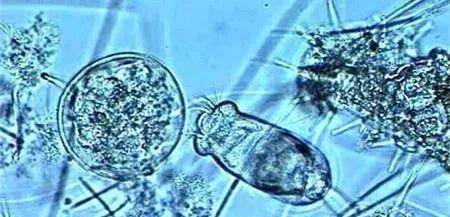Species and movement characteristics of zooplankton:
Zooplankton in the water bodies of culture ponds consist of rotifers, twigs, copepods and protozoa, which are less than 0.2 mm, 0.2-0.6 mm, 0.3-3 mm and 0.5-5 mm in order. In the aquaculture process, zooplankton such as rotifers, copepods and branches are as indispensable natural live bait for aquaculture animals as phytoplankton.
In order to meet the needs of its photosynthesis, the vertical movement phenomenon of floating up during the day and sinking at night with the change of light will be very obvious, while small plant-eating zooplankton will also show the vertical movement law of day and night with phytoplankton floating during the day and down at night in order to meet their feeding needs. However, the active swimming ability of zooplankton is weak, and the swimming ability of small and medium-sized zooplankton is even weaker, and some zooplankton even have no swimming ability at all, can not make long-distance movement, and are not enough to resist the current power of the water. For example, the protozoan flagellar has one or more flagella as a motility organ; the flesh-footed insects move with pseudo-foot telescopic movements; ciliates walk with ciliated jitter; some large zooplankton, such as jellyfish, use the contraction of muscle rings to make parachute-like bodies move.

Zooplankton predation:
Zooplankton are also relatively weak in their ability to prey, and the feeding method is mainly to form water streams to filter food. For example, ciliates generate water flow to collect food by the oscillation of cilia; dart water fleas use the swing of their antennae to produce water flow to ingest small organisms; bran shrimp use thorax swing and rhythmic contraction of gill muscles to produce water flow into the gill cavity to filter food. Another way of feeding for zooplankton is to catch food, prey on other small creatures nearby with the help of pseudopods or tentacles, kill or stick the animal with the thorn cells or sticky cells on the tentacles, and then send them to the mouth to swallow.
The species composition and distribution characteristics of zooplankton are closely related to ecological factors such as water temperature, salinity, dissolved oxygen, chlorophyll a, pH and nutrient salts, among which temperature and salinity are the most important factors affecting the distribution of zooplankton.
Relationship between zooplankton and fry growth:
In the culture pond, the aerator can promote the exchange of upper and lower water bodies, accelerate the circulation of nutrients, and improve the ecological environment. Upwelling water currents caused by aerators can carry nutrients and sediments from the bottom layer near well-lit water surfaces, promoting plankton reproduction and increasing primary productivity and base food levels in ponds.
Experiments have shown that the minimum biomass of Rotifers to ensure good growth of silver carp fry is 3 mg/L, the most appropriate is 20-30 mg/L, and the most appropriate for carp fry is 50-100 mg/L. Large zooplankton of the branches and copepods are also natural live bait for grass carp, carp, crucian carp, bream and bream, as well as other feeding species (2-5 cm).
Because the temperature of zooplankton is mostly between 18-28 ° C, the number of zooplankton often increases significantly in late spring and early summer, which is easy to form an advantage, followed by a large number in autumn; while the summer high temperature is not suitable for zooplankton growth and reproduction, and the biomass is relatively small. We can artificially use and regulate the impact of zooplankton on the fish and water environment and their living laws. For example, in the spring, protozoa and rotifers are cultivated in due course through fertilization, and the peak of rotifers is formed after 4-5 days, and the fry are cultivated in the pond at the right time; after 7-10 days, a large number of branch horns and copepods appear, and the summer flowers go down to the pond at the right time to carry out fish species cultivation. Under fish farming conditions, fish feeding also has a great impact on zooplankton, such as in the later stages of growth in fry ponds.
Pay attention to me so that you can breed without getting lost